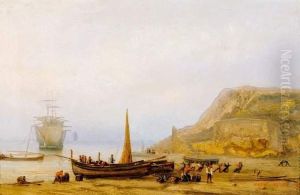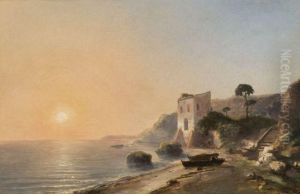Auguste Aiguier Paintings
Auguste Aiguier, born in 1824, was a French landscape painter. Although not as widely recognized as some of his contemporaries, Aiguier developed a unique style that reflected the beauty of the French countryside. His work often captured the serene and bucolic landscapes of France, and he was known for his adept use of light and shadow to give depth and realism to his scenes.
Aiguier studied art at the École des Beaux-Arts in Paris, where he was influenced by the teachings of Romantic painters as well as by the burgeoning Barbizon school, which emphasized the importance of painting nature in its true form. Throughout his career, he exhibited his works at the Paris Salon, the official art exhibition of the Académie des Beaux-Arts in Paris. His paintings were well received by critics and the public alike, who appreciated his dedication to capturing the essence of the French landscape.
Despite his talent, Aiguier never achieved the level of fame of some of his contemporaries, such as Jean-Baptiste-Camille Corot or Gustave Courbet. However, his works were appreciated by connoisseurs and collectors who valued the tranquility and pastoral beauty he portrayed. Aiguier's paintings can be seen as a reflection of the 19th-century French rural ideal, a peaceful escape from the rapidly industrializing cities.
Auguste Aiguier passed away in 1892, leaving behind a body of work that continues to be appreciated for its quiet beauty and skillful execution. His works can be found in various collections and museums, and they serve as a testament to the enduring appeal of French landscape painting in the 19th century.


